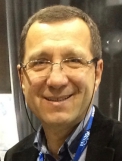Topic:Multi-Fidelity (MF) computational mechanics: benefit from low-cost information to enhance surrogate models
Presenter:Professor Piotr Breitkopf, University of Technology of Compiegne, France
Time:From 15:00 to 17:00 May 9th
Place:On line by Tencent Meeting ID: 359-601-372
Abstract:High-Fidelity (HF) simulation models such as 3D-RANS and LES have reached a level of maturity that allows them to be sufficiently predictive to be used in aeronautical design optimization loops. However, they imply an intensive use of computing resources ranging from a few hours to entire days of computation on supercomputer architectures and the generation of several gigabytes of data. To tackle this issue, we propose to take advantage of several levels of fidelity. Low-Fidelity (LF) models such as simplified physics can be used to compute approximations of fluid flow using limited resources. This is the so-called MF approach, which combines the respective cost and accuracy advantages of LF and HF in a common framework. The use of multiple fidelities has been introduced to temper the cost of high-dimensional multi-disciplinary design breaking the” curse of dimensionality”. This concept allows to predict improved design location by taking into account a large amount of LF cheap data and few expensive HF available data and have proven their efficiency in many applications in aerodynamic optimization.
While surrogate modeling techniques mine embedded quantities, reduced order model captures spatial information in a model approximation by expressing the solution as a linear combination of a limited number of modes. Thereby, assuming that few independent modes govern the system dynamics, a significant reduction in the computational cost of the solution can be achieved. This approach takes into account the full field outputs of the quantities of interest. It consists in building a reduced order model of the solver and expressing, the objective function and the constraints in terms of approximate field. In addition to saving time, this approach has the potential to better understand the detailed characteristics of the flow at each optimization iteration.
ROM-based SBO and MFM raise predictability issues when ROM-based surrogates rely on offline sampling, resulting in costly optimization procedures. To address this problem, offline-online strategies adaptive strategies, are employed to tune the metamodel as the optimization search progresses. The enrichment criterion uses a merit function to predict both the accuracy improvement and the optimization goal. The next point to be evaluated is selected to maximize this criterion iteratively until a suitable stopping condition is reached. The objective is to select the most relevant points in order to reduce the number of calls to the solvers, which would answer a given design problem. Adaptive selection has the advantage of making better use of the available information in a time-efficient way.
The talk will be illustrated by some examples inspired from aeronautic design challenges.
Biography of Presenting Author:

Piotr Breitkopf is the head of the Multidisciplinary Design Optimization team at Université de Technologie de Compiègne (UTC), France. His research fields involve: computational mechanics, reduced order modeling, design optimization and high performance computing. He has obtained his PhD from Polish Academy of Sciences in 1988, and habilitation (HDR) from UTC in 1998. Since 2010 he is Deputy Director of Roberval Laboratory, a joint CNRS-UTC research unit. He is member of the steering committee of Labex MS2T. In 2014 he was nominated Oversea Expert of the Center for Foreign Talents Introduction and Academic Exchange of Mechanical Behavior of Advanced Structures and Materials at NPU. Together with Professor Weihong Zhang he presides the joint French-Chinese research group "Virtual Prototyping and Design". He serves at various editorial boards, scientific councils and scientific associations. He has authored and co-authored more than 200 peer reviewed journal papers, book chapters and referenced conference papers.

 英文
英文




 微信二维码
微信二维码